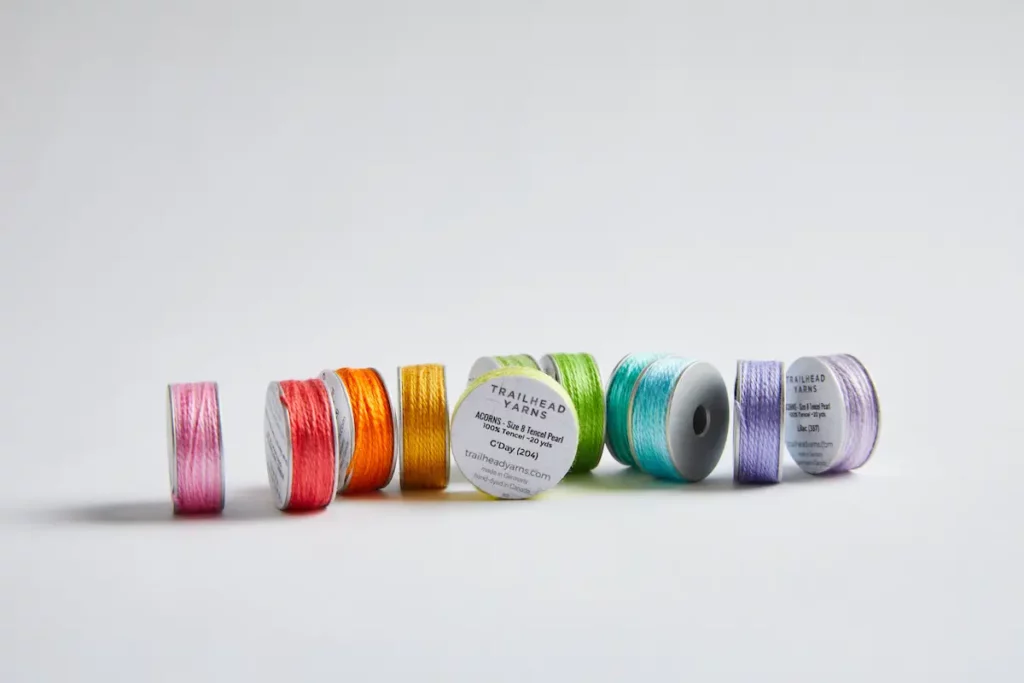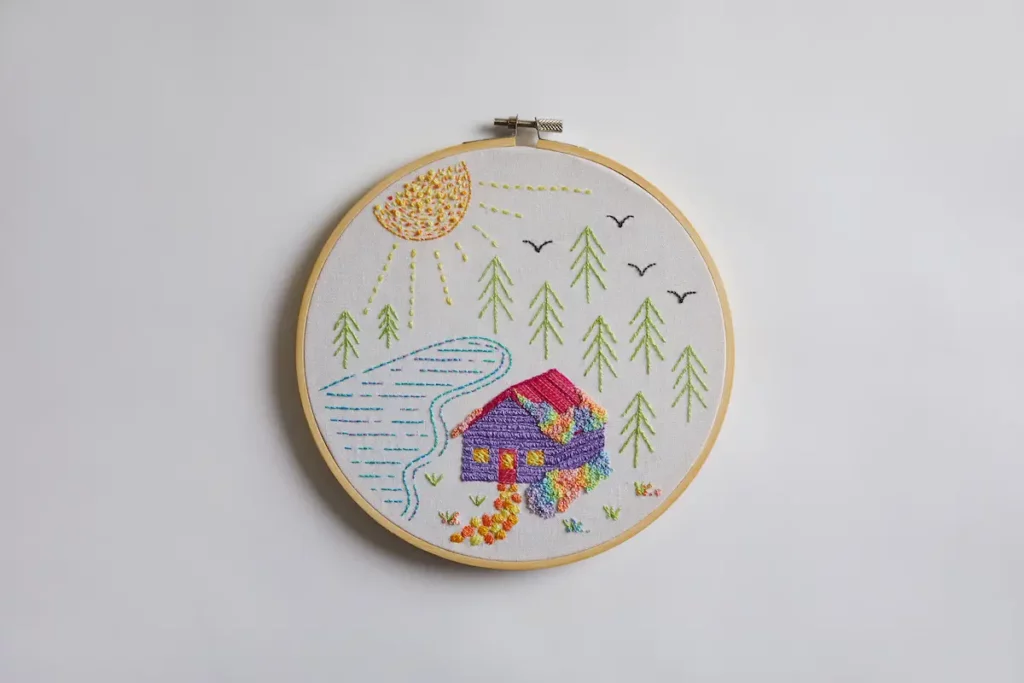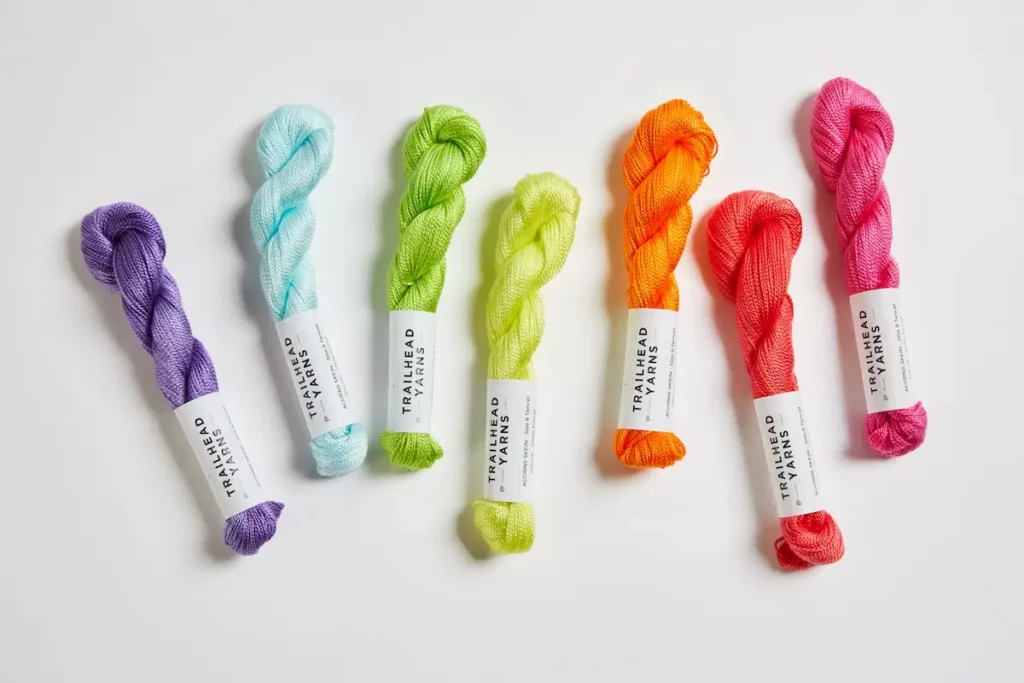What does a fiber artist do when she finds herself allergic to her favorite materials? If you are Samantha Van Noy, you find ways to create hand dyed yarns from alternative fibers. When she discovered she was allergic to wool, Samantha developed her own processes to dye alternative fibers such as Tencel and cotton, giving her – and other wool-shy fiber artists – a creative palette with the depth and richness of traditional yarn.

How did you find yourself on a creative path? Always there? Lightbulb moment? Dragged kicking and screaming? Evolving?
I’ve always been a creative person. It’s been part of my life since I can remember. Creating, and in particular starting new projects, would ease my anxiety. It has been a part of my self-care routine since before I knew what self-care was. I was lucky to find a way to make being creative my life’s work and love that I am able to help others be creative now.
What inspires you to create? How does your environment influence your creativity?
My creativity comes from everything I see. Often my creative spark comes from what I see in nature. The unexpected colours of a piece of lichen or the awe of the sky can inspire my work. Before dyeing yarn and thread I studied forestry and worked in the outdoor adventure industry. My time in nature is very important to my process.
As an Amazon Associate I earn from qualifying purchases. Read more about our affiliate linking policy.

Why fiber? How does that medium best express what you want to communicate through your art?
Textiles have always been a medium I connected with naturally. I started at the age of 5 and kept trying new forms of the medium from sewing, crochet, knitting, cross stitch and eventually spinning, weaving and dyeing.
When I started my master spinner certificate program, I learned to dye, and it gave me a new way to interpret colour. Blending colours of fiber together allowed me to experiment as my dyeing skills caught up with the vision I had. I love the ability to blend techniques when it comes to fibre arts from raw fibre to finished items. There are many different parts of the process. I can mix and match them to create a unique item with a unique path to get there.

What inspired you to specialize in vegan yarns? What makes them unique?
I had no plans on starting a vegan yarn company. I actually started in wool.
After years of dyeing, felting, knitting and weaving wool I suddenly became allergic to all wool. My specialty was Canadian wool, and I prided myself in sourcing fibre directly from the sheep and producing unique yarns. When my allergy started it was obvious that wool would no longer be an option. My allergy symptoms were respiratory, and breathing is essential. Honestly, at first, I was going to just get out of the industry, but I couldn’t find any yarns on the market that I wanted to work with.
Nothing compared to the amazing hand-dyed yarns I was accustomed to. I knew there must be other people like me who can’t or don’t want to use wool who would love options. Within a week I had samples of yarn bases on their way and the appropriate dyes on order.
Which of your plant-based fibers is most popular? Why do you think that is?
My most popular yarn is my cotton sock yarn which is custom made to my specifications. The weight, familiarity with cotton, and the availability of fingering weight patterns I believe is why it’s so popular. With that being said the Tencel thread we hand-dye is now our favorite because anyone who can thread a needle and stab fabric can use it for embroidery.

How do you start your studio day?
My days in the studio vary a lot and running a business does mean I don’t get to spend every day creating. I love starting my days checking in on the community of creative product-based businesses I am part of before diving into my work for the day.
Sitting with my coffee in the office, but through technology being able to reach out to hundreds of other creatives, is incredible. Without that the studio would be a lonely place day in and day out.
When it comes to creating, are you more of a planner or an improviser?
I LOVE to plan things. I live on graph paper and make detailed plans which is part of the reason I love quilting so much.
Dyeing is a mix of science and art. I like planning my colourways but regularly like to give myself permission to just play. These are unique colourways that can’t be reproduced but they feed my creative spirit which sometimes needs that extra boost.

Do you have a dedicated space for creating? If so, what does it look like?
For my dyeing, I currently have a 1000 square foot studio which features a dedicated dyeing area, rinsing and drying space, storage room, shipping desk, and an entire space for winding thread onto our signature bobbins. At home I also have a dedicated room for sewing, along with my dining room which houses all my books and an ironing table. Good thing I’m single so I can dedicate a lot of my space to my creative process.
What is your favorite storage tip for your creative supplies?
My favorite storage tip has to be to display your supplies as though they are decor. You’ll have so much more room for your yarn, fabric, thread, etc. if you can have them spread through your home in an intentional way.

What are the indispensable tools and materials in your studio? How do they improve your work?
The most important tool is your body. Take care of your body and you will be able to enjoy your creative process for years to come. As a dyer I need to have limber hands, healthy shoulders, and a strong core. A small injury can make creating impossible, so I try my best to stay healthy and active. Dyeing is physically demanding.
One item which I could not live without is an anti-fatigue mat. It helps keep my lower body from getting sore when standing for a significant period of time.
Do you use a sketchbook or journal? How does that help your work develop?
Stacks of paper are usually all around me. I wish a notebook was something that worked for me, but loose pages of graph paper are more my jam. I don’t think in the most linear way, so I jump around from one idea to another, and loose pages allow me to reorganize the order. Notebooks can be so pretty, and I love buying them but never seem to fill any.

What plays in the background while you work? Silence? Music, audiobooks, podcasts, movies? If so, what kind?
When I’m dyeing, I usually just have the radio on. But then when winding bobbins of thread my headphones go on and I binge podcasts about cults which is a guilty pleasure.
At home when I’m creative I usually have a documentary playing in the background. I can’t be the only one who spends her days watching WWII documentaries while sitting at her sewing machine.
What do you do to keep yourself motivated and interested in your work?
My work is always evolving which keeps me excited. I like creating new colourways and sometimes will throw in a limited edition colour into the lineup just to shake things up. Doing colour pulls and creating new bundles with existing colours helps me bring new life to colours that I created years ago.

If you could interview a creative person (past or present), who would that person be? What is it about that person that intrigues you?
My favorite artist who inspired a lot of how I see colour is Lawren Harris, a member of the Group of Seven. A painting of his had purple and yellow rocks and it just set me on a path of seeing nature in a different way. If I could spend a few weeks in the forest with him and see how he gains his inspiration it would be an honor.

When was the first time that you remember realizing that you are a creative person?
Being creative is something I’ve always known about myself. However, I think I was a preteen the first time I realized how unique that was. I couldn’t sleep one night because I felt the need to make my vision of a skirt using scraps of denim come to life. By morning I had a floor length A-line skirt made from a mosaic of denim. That night I believe was a changing point in my creative journey.
Do you think that creativity comes naturally to people, or do you think creativity is a skill that people can learn?
Everyone can be creative in their own way. It’s more about what medium you use to make that creativity come to life.
I hope I can inspire people to create in their own way. Don’t be afraid to pick up some supplies and create something. Know it will never be perfect and that is perfectly ok. Enjoy the process and see value in working with your hands.
Interview posted December 2022
Browse through more inspiring hand embroidery projects and interviews on Create Whimsy.

